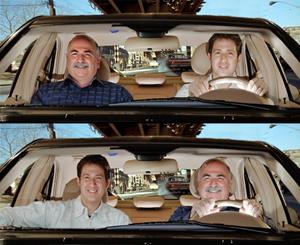

Good news for control freaks!
New research confirms that having some authority over how one takes in new information significantly enhances one’s ability to remember it.
“Having active control over a learning situation is very powerful and we're beginning to understand why,” said U of I psychology professor Neal Cohen, who led the study with postdoctoral researcher Joel Voss. “Whole swaths of the brain not only turn on, but also get functionally connected when you're actively exploring the world.”
The study focused on activity in several brain regions, including the hippocampus, located in the brain's medial temporal lobes, near the ears. Researchers have known for decades that the hippocampus is vital to memory, in part because those who lose hippocampal function as a result of illness or injury also lose their ability to fully form and retain new memories.
But the hippocampus doesn’t act alone. Robust neural connections tie it to other important brain structures, and traffic on these data highways flows in both directions. Functional magnetic resonance imaging (fMRI) studies, which track blood flow in the brain, show that the hippocampus is functionally connected to several brain networks—distinct regions of the brain that work in tandem to accomplish critical tasks.
To better understand how these brain regions influence active versus passive learning, Voss designed an experiment that required participants to memorize an array of objects and their exact locations in a grid on a computer monitor. A gray screen with a window in it revealed only one object at a time.
The “active” study subjects used a computer mouse to guide the window to view the objects. The “passive” learners viewed a replay of the window movements recorded in a previous trial by an active subject.
Then participants were asked to select the items they had seen and place them in their correct positions on the screen. After a trial, the active and passive subjects switched roles and repeated the task with a new array of objects.
The study found that those who had active control over the viewing window were significantly better than their peers at identifying the original objects and their locations. (Further experiments established that this effect was independent of the act of moving the mouse.)
Brain Areas Active in Learning
By performing the same tests on individuals who had amnesia as a result of hippocampal damage, the researchers were able to identify the brain mechanisms that enhance active learning. To their surprise, the latter participants failed to benefit from actively controlling the viewing window.
“These data suggest that the hippocampus has a role not just in the formation of new memory but possibly also in the beneficial effects of volitional control on memory,” the researchers wrote.
Brain imaging (by means of fMRI) of healthy young subjects engaged in the same active and passive learning tests revealed that hippocampal activity was highest in the active subjects’ brains during these tests. Several other brain structures were also more engaged when the subject controlled the viewing window, and activity in these brain regions was more synchronized with that of the hippocampus than in the passive trials.
Activity in the dorsolateral prefrontal cortex, the cerebellum, and the hippocampus was higher, and more highly coordinated, in participants who did well on spatial recall, the researchers found. Increased activity in the inferior parietal lobe, the parahippocampal cortex, and the hippocampus corresponded to better performance on item recognition.


